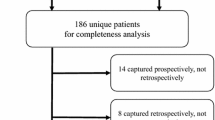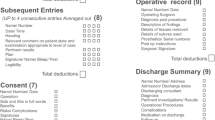Abstract
Background
The Pietermaritzburg Metropolitan Trauma Service previously successfully constructed and implemented an electronic surgical registry (ESR). This study reports on our attempts to expand and develop this concept into a multi-functional hybrid electronic medical record (HEMR) system for use in a tertiary level surgical service. This HEMR system was designed to incorporate the function and benefits of an ESR, an electronic medical record (EMR) system, and a clinical decision support system (CDSS).
Methods
Formal ethical approval to maintain the HEMR system was obtained. Appropriate software was sourced to develop the project. The data model was designed as a relational database. Following the design and construction process, the HEMR file was launched on a secure server. This provided the benefits of access security and automated backups. A systematic training program was implemented for client training. The exercise of data capture was integrated into the process of clinical workflow, taking place at multiple points in time. Data were captured at the times of admission, operative intervention, endoscopic intervention, adverse events (morbidity), and the end of patient care (discharge, transfer, or death).
Results
A quarterly audit was performed 3 months after implementation of the HEMR system. The data were extracted and audited to assess their quality. A total of 1,114 patient entries were captured in the system. Compliance rates were in the order of 87–100 %, and client satisfaction rates were high.
Conclusions
It is possible to construct and implement a unique, simple, cost-effective HEMR system in a developing world surgical service. This information system is unique in that it combines the discrete functions of an EMR system with an ESR and a CDSS. We identified a number of potential limitations and developed interventions to ameliorate them. This HEMR system provides the necessary platform for ongoing quality improvement programs and clinical research.








Similar content being viewed by others

References
Laing GL, Bruce JL, Aldous C et al (2013) The design, construction and implementation of a computerized trauma registry in a developing South African metropolitan trauma service. Injury 45:3–8
Mintzberg M (1994) Harvard business review. (January/February) pp 107–114
Bilimoria KY, Kmiecik TE, DaRosa DA et al (2009) Development of an online morbidity, mortality and near-miss reporting system to identify patterns of adverse events in surgical patients. Arch Surg 144:305–311
Nwomeh BC, Lowell W, Kable R et al (2006) History and development of trauma registry: lessons from developed to developing countries. World Emerg J Surg 1:32. doi:10.1186/1749-7922-1-32
Mehmood A, Razzak JA, Kabir S et al (2013) Development and pilot implementation of a locally developed trauma registry: lessons learnt in a low-income country. BMC Emerg Med 13:4
O’Reilly GM, Joshipura M, Cameron PA et al (2013) Trauma registries in developing countries: a review of the published experience. Injury 44:713–721
Schuurman N, Cinnamon J, Matzopoulos R et al (2011) Collecting injury surveillance data in low- and middle-income countries: the Cape Town Trauma Registry pilot. Glob Public Health 6:874–889
Royal Australasian College of Surgeons (2002) Surgical audit and peer review guidelines. Royal Australasian College of Surgeons, Melbourne
Author information
Authors and Affiliations
Corresponding author
Appendix
Appendix
See Table 8.
Rights and permissions
About this article
Cite this article
Laing, G.L., Bruce, J.L., Skinner, D.L. et al. Development, Implementation, and Evaluation of a Hybrid Electronic Medical Record System Specifically Designed for a Developing World Surgical Service. World J Surg 38, 1388–1397 (2014). https://doi.org/10.1007/s00268-013-2438-2
Published:
Issue Date:
DOI: https://doi.org/10.1007/s00268-013-2438-2



